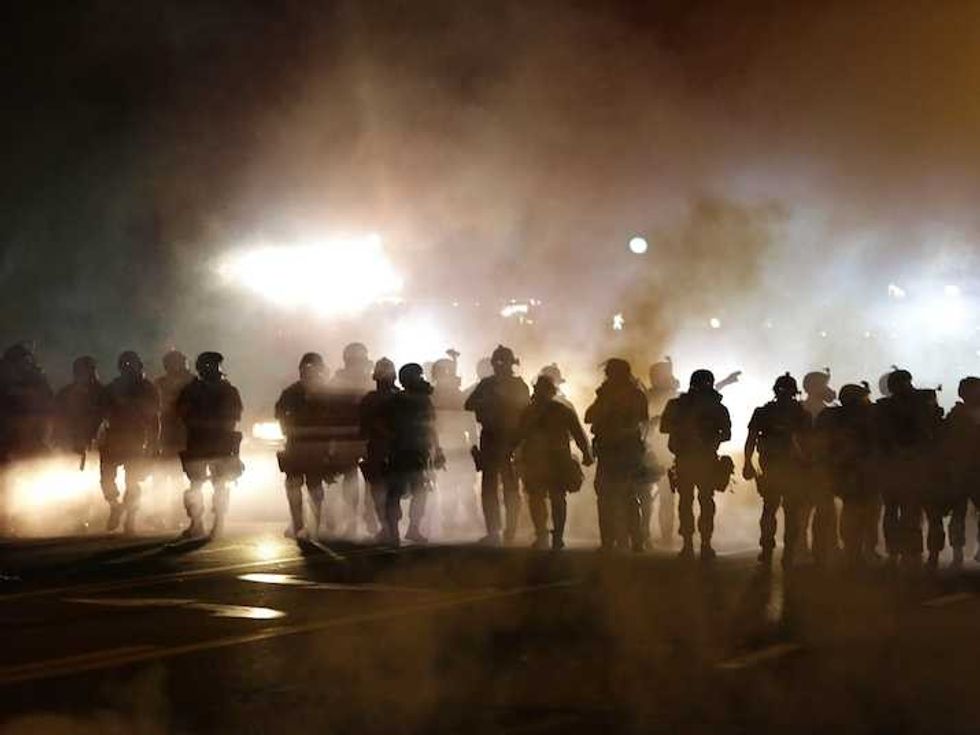No-Fly Zone Used To Block News Choppers During Protests In Ferguson, MO

Newly-released audio recordings have revealed that police restricted 37 miles of airspace over Ferguson, Missouri in order to block overhead news coverage of protests following the killing of unarmed teen Michael Brown. The federal government and the Federal Aviation Administration initiated the no-fly zone for 12 days following Brown's death in response to a request from the St. Louis County Police Department, citing safety concerns. The Associated Press, after obtaining the recordings under a Freedom of Information Act request, detailed the exact parameters of the restriction:
The restricted flight zone initially encompassed airspace in a 3.4-mile radius around Ferguson and up to 5,000 feet in altitude, but police agreed to reduce it to 3,000 feet after the FAA's command center in Warrenton, Virginia, complained to managers in Kansas City that it was impeding traffic into St. Louis.The flight restrictions remained in place until Aug. 22, FAA records show. A police captain wanted it extended when officials were set to identify Wilson by name as the officer who shot Brown and because Brown's funeral would "bring out the emotions," the recordings show.
"We just don't know what to expect," he told the FAA. "We're monitoring that. So, last night we shot a lot of tear gas, we had a lot of shots fired into the air again. It did quiet down after midnight, but with that ... we don't know when that's going to erupt."
A recent New York Times article details how the real reason for the ban was discovered:
On Aug. 12, the morning after the Federal Aviation Administration imposed the first flight restriction, the agency’s air traffic managers struggled to redefine the flight ban to allow commercial flights to operate at nearby Lambert-St. Louis International Airport and for police helicopters to fly through the area — while still prohibiting flights.“They finally admitted it really was to keep the media out,” one administration manager said about the St. Louis County Police Department in a series of recorded telephone conversations obtained by The Associated Press. “But they were a little concerned of, obviously, anything else that could be going on.”
At another point, referring to the temporary flight restriction, a manager at the administration’s center in Kansas City, Mo., said the police “did not care if you ran commercial traffic through this T.F.R. all day long. They didn’t want media in there.”
The manager said there was “no option for a T.F.R. that says, you know, ‘OK, everybody but the media is OK.’ ” The managers then developed wording that they felt would keep news helicopters out of the controlled zone but not impede other air traffic.
This information counters the St. Louis County Police Department's ongoing claim that they requested the ban in response to shots fired at police helicopters. The SLCPD has maintained their stance, stating that "the restriction was solely for safety and had nothing to do with preventing news media from witnessing the violence or police response to demonstrations after the shooting death of 18-year-old Michael Brown." The F.A.A. has referred to reports of shooting at police choppers as "unconfirmed rumors." Continuing, agency administrator Michael Huerta issued a statement Sunday outlining the agency's stance on the matter, which explicitly supports the media's right to cover events:
“F.A.A. cannot and will never exclusively ban media from covering an event of national significance, and media was never banned from covering the ongoing events in Ferguson in this case,” he said.
Read the full story via nytimes.com and get further details via bigstory.ap.org. Stay tuned for more.
Spotted at AP & NYT.


